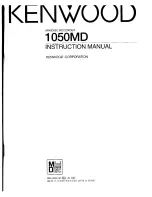
4
5
EXCLUSION ZONES
An exclusion zone is defined as the minimum distance
permitted between instrumentation devices and the point
where EMI/RFI emitters may be activated. Within an exclusion
zone, the activation of e.g. handheld two-way radios is
prohibited.
As a general rule, transmitting devices must always be
operated at least 'an arms length' away from any
instrumentation.
Administrative controls should be used to establish exclusion
zones in specified areas where instrumentation and control
systems have been installed and are operational.
Fig. 5.1 EMI Field Strength (Volts/Meter) vs Distance (Feet) vs Radiated Power (Watts)
Notes
.
• 10V/m corresponds to the CE mark testing field strength limit standard.
• 4V/m corresponds to the NRC 8dB de-rating of the 10V/m field strength limit.
The size of the exclusion zone(s) should be site-specific and
dependent upon the effective radiated power of the portable
EMI/RFI emitter type(s) likely to be used.
Exclusion Zone
Some examples of exclusion zone distances recognized by
European Industry standards (for CE marking), and by the
U.S. Nuclear Regulatory Commission (NRC) are shown in
Figure 5.1 below.
Table 5.1 shows some examples of relationships between
radiated power, distance and EMI field strength, derived from
the graphs in Figure 5.1.
EMI Field Strength vs Distance vs Radiated Power
0
5
10
15
20
25
30
35
40
45
50
55
60
0.5
1
1.5
2
2.5
3
3.5
4
4.5
5
5.5
6
6.5
7
7.5
8
8.5
9
9.5
10
Feet
V
olts / meter
0.5W
1W
2W
4W
5W
8W
10W
10 V/m Limit
4 V/m Limit
r
e
w
o
P
d
e
t
a
i
d
a
R
)
s
t
t
a
W
(
t
u
p
t
u
O
e
c
n
a
t
s
i
D
m
/
V
0
1
)
t
e
e
F
(
e
c
n
a
t
s
i
D
m
/
V
4
)
t
e
e
F
(
5
0
.
4
0
.
0
1
2
5
.
2
4
.
6
1
8
.
1
5
.
4
5
.
0
3
.
1
2
.
3
Summary of Contents for C1950
Page 7: ...Sales Software Service ...


























